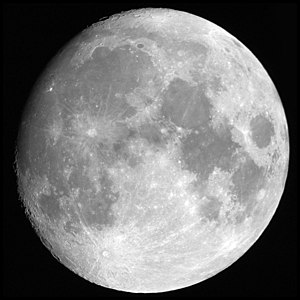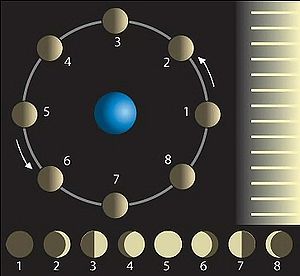Moon: Earth's only natural satellite
The Moon is Earth's only natural satellite.
We usually see it in the night sky and also during the day. Some other planets also have moons or natural satellites.
 The Moon as seen from Earth. This is a nearly full moon | |||||||||||||
| Designations | |||||||||||||
|---|---|---|---|---|---|---|---|---|---|---|---|---|---|
| Luna | |||||||||||||
| Adjectives | lunar, selenic | ||||||||||||
| Orbital characteristics | |||||||||||||
| Perigee | 363,104 km (0.002 4 AU) | ||||||||||||
| Apogee | 405,696 km (0.002 7 AU) | ||||||||||||
| 384,399 km (0.002 57 AU) | |||||||||||||
| Eccentricity | 0.054 9 | ||||||||||||
| 27.321 582 d (27 d 7 h 43.1 min) | |||||||||||||
| 29.530 589 d (29 d 12 h 44 min 2.9 s) | |||||||||||||
Average orbital speed | 1.022 km/s | ||||||||||||
| Inclination | 5.145° to the ecliptic (between 18.29° and 28.58° to Earth's equator) | ||||||||||||
| regressing by one revolution in 18.6 years | |||||||||||||
| progressing by one revolution in 8.85 years | |||||||||||||
| Satellite of | Earth | ||||||||||||
| Physical characteristics | |||||||||||||
Mean radius | 1,737.10 km (0.273 Earths) | ||||||||||||
| Flattening | 0.001 25 | ||||||||||||
| Circumference | 10,921 km (equatorial) | ||||||||||||
| 3.793 × 107 km² (0.074 Earths) | |||||||||||||
| Volume | 2.195 8 × 1010 km³ (0.020 Earths) | ||||||||||||
| Mass | 7.347 7 × 1022 kg (0.012 3 Earths) | ||||||||||||
Mean density | 3,346.4 kg/m³ | ||||||||||||
| 1.622 m/s² (0.165 4 g) | |||||||||||||
| 2.38 km/s | |||||||||||||
Sidereal rotation period | 27.321 582 d (synchronous) | ||||||||||||
Equatorial rotation velocity | 4.627 m/s | ||||||||||||
| 1.542 4° (to ecliptic) 6.687° (to orbit plane) | |||||||||||||
| Albedo | 0.12 | ||||||||||||
| |||||||||||||
| −2.5 to −12.9 −12.74 (mean full moon) | |||||||||||||
| 29.3 to 34.1 arcminutes | |||||||||||||
Surface pressure | 2.25 × 10-12 torr | ||||||||||||
Our moon is about one-fourth of the width of the Earth. Because it is far away it looks small, about half a degree wide. The gravity on the moon is one-sixth of the Earth's gravity. It means that something will be one-sixth as heavy on the Moon than on Earth. The Moon is a rocky and dusty place. It moves slowly away from the Earth at a rate of 3.8 cm per year, due to the effect of tidal dissipation.
For the origin of the Moon, see the giant impact hypothesis.
Phases
Because the Moon is round, half of it is lit up by the Sun. As it goes around (or orbits) the Earth, sometimes the side that people on Earth can see is all lit brightly. Other times only a small part of the side we see is lit. This is because the Moon does not send out its own light. People only see the parts that are being lit by sunlight. These different stages are called Phases of the Moon.
It takes the Moon about 29.53 days (29 days, 12 hours, 44 minutes) to complete the cycle, from big and bright to small and dim and back to big and bright. The phase when the Moon passes between the Earth and Sun is called the new Moon. The next phase of the Moon is called the "waxing crescent", followed by the "first quarter", "waxing gibbous", then a full Moon. A full Moon occurs when the Moon and Sun are on opposite sides of the Earth. As the Moon continues its orbit it becomes a "waning gibbous", "third quarter", "waning crescent", and finally back to a new Moon. People used the Moon to measure time. A month is approximately equal in time to a lunar cycle.

The Moon always shows the same side to Earth. Astronomers call this phenomenon tidal locking. This means that half of it can never be seen from Earth. The side facing away from Earth is called the far side or dark side of the Moon even though the Sun does shine on it—we just never see it lit.
History of exploring the Moon

Before people stood on the Moon, the United States and the USSR sent robots to the Moon. These robots would orbit the Moon or land on its surface. The robots were the first man-made objects to touch the Moon.
Humans finally landed on the Moon on July 21, 1969. Astronauts Neil Armstrong and Buzz Aldrin landed their lunar ship (the Eagle) on the surface of the Moon. Then, as half the world watched him on television, Armstrong climbed down the ladder of the Eagle and was the first human to touch the Moon as he said, "That's one small step for a man, one giant leap for mankind."
Even though their footprints were left on the moon a long time ago, it is likely that they are still there, as there is no wind or rain, making erosion extremely slow. The footprints do not get filled in or smoothed out.
More people landed on the moon between 1969 and 1972, when the last spaceship, Apollo 17 visited. Eugene Cernan of Apollo 17 was the last person to touch the moon.
Characteristics
Because it is smaller, the Moon has less gravity than Earth (only 1/6 of the amount on Earth). So if a person weighs 60 kilograms on Earth, the person would only weigh 10 kilograms on the Moon. But even though the Moon's gravity is weaker than the Earth's gravity, it is still there. If a person dropped a ball while standing on the Moon, it would still fall down. However, it would fall much more slowly. A person who jumped as high as possible on the Moon would jump higher than on Earth, but still fall back to the ground. Because the Moon has no atmosphere, there is no air resistance, so a feather will fall as fast as a hammer.
Without an atmosphere, the environment is not protected from heat or cold. Astronauts wore spacesuits, and carried oxygen to breathe. The gloves of the spacesuit, were never taken off on the Moon. The suit weighed about as much as the astronaut. The Moon's gravity is weak, so it was not as heavy as on Earth.
On the Earth, the sky is blue because the blue rays of the Sun bounce off the gases in the atmosphere, making it look like blue light is coming from the sky. But on the Moon, because there is no atmosphere, the sky looks black, even in the daytime. There is no atmosphere to protect the Moon from rocks that come from space, and these meteorites crash right into the Moon and make wide, shallow holes called craters. The Moon has thousands of them. Newer craters overlie older ones. On Earth, meteorites burn in the atmosphere, and most burn up completely.
Origin of the Moon
The giant impact hypothesis is that the Moon was created out of the debris from a collision between the young Earth and a Mars-sized protoplanet. This is the favored scientific hypothesis for the formation of the Moon.
Water on the Moon
In 2009 Chandrayaan-1 found a lot of water on the Moon. The water is not liquid but is in the form of hydrates and hydroxides. Liquid water cannot exist on the Moon because photodissociation quickly breaks down the molecules. However, from the data received from Chandrayaan-1, liquid surface water may have once existed on the Moon.
Legal status
During the Cold War, the United States Army thought about making a military post on the Moon, able to attack targets on Earth. They also considered testing a nuclear weapon on the Moon. The United States Air Force had similar plans. However, both plans were brushed-off as NASA moved from a military to a civilian-based agency.
Even though the Soviet Union left remains on the Moon, and the United States left a few flags, no country has control over the Moon. The U.S. and Soviet Union both signed the Outer Space Treaty, which calls the Moon and all of outer space the "province of all mankind". This treaty also banned all use of the military of the Moon, including nuclear weapons tests and military bases.
Related pages
References
More reading
- Iggulden, Hal; Iggulden, Conn (2007). "The Moon". The Dangerous Book for Boys. New York: HarperCollins. pp. 167–170. ISBN 978-0061243585.
Other websites
 Media related to Moon at Wiki Commons
Media related to Moon at Wiki Commons
- The Dark Side of the Moon Archived 2011-05-20 at the Wayback Machine
This article uses material from the Wikipedia Simple English article Moon, which is released under the Creative Commons Attribution-ShareAlike 3.0 license ("CC BY-SA 3.0"); additional terms may apply (view authors). Content is available under CC BY-SA 4.0 unless otherwise noted. Images, videos and audio are available under their respective licenses.
®Wikipedia is a registered trademark of the Wiki Foundation, Inc. Wiki Simple English (DUHOCTRUNGQUOC.VN) is an independent company and has no affiliation with Wiki Foundation.